Towards Discriminative Class-Aware Domain Alignment via Coding Rate Reduction for Unsupervised Adversarial Domain Adaptation
Abstract
1. Introduction
- We combine conditional adversarial domain adaptation with domain-specific batch normalization for GDA to learn robust domain-invariant features.
- We propose GCR2 and LCR2 methods, achieving discriminative class-aware domain alignment for unsupervised adversarial domain adaptation.
- A new unsupervised adversarial domain adaptation framework is proposed to facilitate the end-to-end training with GDA, GCR2, and LCR2, improving the learning of the symmetry between domains.
- Extensive experiments have showcased the effectiveness of CR2ADA when compared to state-of-the-art UDA methods, across four UDA benchmark datasets.
2. Background
3. Related Work
3.1. Adversarial Domain Adaptation
3.2. Coding Rate
4. Methodology
4.1. Overview
4.2. Preliminary
4.2.1. Global Domain Alignment
4.2.2. Learning Discriminative Features via Coding Rate
4.3. Discriminative Class-Aware Domain Alignment
4.3.1. Global Coding Rate Reduction
4.3.2. Local Coding Rate Reduction
4.4. Overall Optimization
| Algorithm 1 Optimization of CR2ADA |
|
5. Experiments
5.1. Experimental Setup
5.1.1. Datasets
5.1.2. Implementation Details
5.2. Performance Analysis
5.3. Ablation Study
5.4. Sensitivity Analysis of the Parameters
5.5. Visual Analysis
5.6. Distribution Discrepancy
6. Limitations and Future Research
7. Conclusions
Author Contributions
Funding
Data Availability Statement
Acknowledgments
Conflicts of Interest
References
- He, K.; Zhang, X.; Ren, S.; Sun, J. Deep residual learning for image recognition. In Proceedings of the IEEE/CVF Conference on Computer Vision and Pattern Recognition, Las Vegas, NV, USA, 27–30 June 2016; pp. 770–778. [Google Scholar]
- Zhao, B.; Feng, J.; Wu, X.; Yan, S. A survey on deep learning-based fine-grained object classification and semantic segmentation. Int. J. Autom. Comput. 2017, 14, 119–135. [Google Scholar] [CrossRef]
- Zhang, L.; Gao, X. Transfer adaptation learning: A decade survey. IEEE Trans. Neural Netw. Learn. Syst. 2022, 35, 23–44. [Google Scholar] [CrossRef] [PubMed]
- Pan, S.J.; Yang, Q. A survey on transfer learning. IEEE Trans. Knowl. Data Eng. 2009, 22, 1345–1359. [Google Scholar] [CrossRef]
- Ben-David, S.; Blitzer, J.; Crammer, K.; Kulesza, A.; Pereira, F.; Vaughan, J.W. A theory of learning from different domains. Mach. Learn. 2010, 79, 151–175. [Google Scholar] [CrossRef]
- Wang, Z.; Mao, Y. Information-Theoretic Analysis of Unsupervised Domain Adaptation. In Proceedings of the Eleventh International Conference on Learning Representations, Kigali, Rwanda, 1–5 May 2023. [Google Scholar]
- Yosinski, J.; Clune, J.; Bengio, Y.; Lipson, H. How transferable are features in deep neural networks? In Advances in Neural Information Processing Systems; Curran Associates, Inc.: New York, NY, USA, 2014; Volume 27. [Google Scholar]
- Long, M.; Cao, Y.; Wang, J.; Jordan, M. Learning transferable features with deep adaptation networks. In Proceedings of the International Conference on Machine Learning, PMLR, Lille, France, 7–9 July 2015; pp. 97–105. [Google Scholar]
- Ganin, Y.; Ustinova, E.; Ajakan, H.; Germain, P.; Larochelle, H.; Laviolette, F.; Marchand, M.; Lempitsky, V. Domain-adversarial training of neural networks. J. Mach. Learn. Res. 2016, 17, 1–35. [Google Scholar]
- Zhou, L.; Ye, M.; Zhu, X.; Li, S.; Liu, Y. Class Discriminative Adversarial Learning for Unsupervised Domain Adaptation. In Proceedings of the 30th ACM International Conference on Multimedia, Lisboa, Portugal, 10–14 October 2022; pp. 4318–4326. [Google Scholar]
- Goodfellow, I.; Pouget-Abadie, J.; Mirza, M.; Xu, B.; Warde-Farley, D.; Ozair, S.; Courville, A.; Bengio, Y. Generative adversarial nets. In Advances in Neural Information Processing Systems; Curran Associates, Inc.: New York, NY, USA, 2014; Volume 27. [Google Scholar]
- Xie, S.; Zheng, Z.; Chen, L.; Chen, C. Learning semantic representations for unsupervised domain adaptation. In Proceedings of the International Conference on Machine Learning, PMLR, Stockholm, Sweden, 10–15 July 2018; pp. 5423–5432. [Google Scholar]
- Kang, G.; Jiang, L.; Yang, Y.; Hauptmann, A.G. Contrastive adaptation network for unsupervised domain adaptation. In Proceedings of the IEEE/CVF Conference on Computer Vision and Pattern Recognition, Long Beach, CA, USA, 16–20 June 2019; pp. 4893–4902. [Google Scholar]
- He, Q.; Xiao, S.; Ye, M.; Zhu, X.; Neri, F.; Hou, D. Independent Feature Decomposition and Instance Alignment for Unsupervised Domain Adaptation. In Proceedings of the International Joint Conference on Artificial Intelligence, Macao, China, 19–25 August 2023; pp. 819–827. [Google Scholar]
- Yu, Y.; Chan, K.H.R.; You, C.; Song, C.; Ma, Y. Learning diverse and discriminative representations via the principle of maximal coding rate reduction. Adv. Neural Inf. Process. Syst. 2020, 33, 9422–9434. [Google Scholar]
- Pan, S.J.; Tsang, I.W.; Kwok, J.T.; Yang, Q. Domain adaptation via transfer component analysis. IEEE Trans. Neural Netw. 2010, 22, 199–210. [Google Scholar] [CrossRef] [PubMed]
- Gretton, A.; Sejdinovic, D.; Strathmann, H.; Balakrishnan, S.; Pontil, M.; Fukumizu, K.; Sriperumbudur, B.K. Optimal kernel choice for large-scale two-sample tests. In Advances in Neural Information Processing Systems; Curran Associates, Inc.: New York, NY, USA, 2012; Volume 25. [Google Scholar]
- Long, M.; Zhu, H.; Wang, J.; Jordan, M.I. Deep transfer learning with joint adaptation networks. In Proceedings of the International Conference on Machine Learning, PMLR, Sydney, Australia, 6–11 August 2017; pp. 2208–2217. [Google Scholar]
- Sun, B.; Feng, J.; Saenko, K. Correlation alignment for unsupervised domain adaptation. In Domain Adaptation in Computer Vision Applications; Springer: Berlin/Heidelberg, Germany, 2017; pp. 153–171. [Google Scholar]
- Li, M.; Zhai, Y.M.; Luo, Y.W.; Ge, P.F.; Ren, C.X. Enhanced transport distance for unsupervised domain adaptation. In Proceedings of the IEEE/CVF Conference on Computer Vision and Pattern Recognition, Seattle, WA, USA, 14–19 June 2020; pp. 13936–13944. [Google Scholar]
- Liu, Y.; Zhou, Z.; Sun, B. COT: Unsupervised Domain Adaptation With Clustering and Optimal Transport. In Proceedings of the IEEE/CVF Conference on Computer Vision and Pattern Recognition, Vancouver, BC, Canada, 18–24 June 2023; pp. 19998–20007. [Google Scholar]
- Chang, W.G.; You, T.; Seo, S.; Kwak, S.; Han, B. Domain-specific batch normalization for unsupervised domain adaptation. In Proceedings of the IEEE/CVF Conference on Computer Vision and Pattern Recognition, Long Beach, CA, USA, 16–20 June 2019; pp. 7354–7362. [Google Scholar]
- Jin, Y.; Wang, X.; Long, M.; Wang, J. Minimum class confusion for versatile domain adaptation. In Proceedings of the European Conference on Computer Vision, Glasgow, UK, 23–28 August 2020; Springer: Berlin/Heidelberg, Germany, 2020; pp. 464–480. [Google Scholar]
- Li, S.; Xie, M.; Lv, F.; Liu, C.H.; Liang, J.; Qin, C.; Li, W. Semantic concentration for domain adaptation. In Proceedings of the IEEE/CVF International Conference on Computer Vision, Montreal, BC, Canada, 11–17 October 2021; pp. 9102–9111. [Google Scholar]
- Zhao, H.; Ma, C.; Chen, Q.; Deng, Z.H. Domain Adaptation via Maximizing Surrogate Mutual Information. In Proceedings of the International Joint Conference on Artificial Intelligence, Vienna, Austria, 23–29 July 2022; pp. 1700–1706. [Google Scholar]
- Zhou, L.; Ye, M.; Zhu, X.; Xiao, S.; Fan, X.Q.; Neri, F. Homeomorphism Alignment for Unsupervised Domain Adaptation. In Proceedings of the IEEE/CVF International Conference on Computer Vision, Paris, France, 2–6 October 2023; pp. 18699–18710. [Google Scholar]
- Tian, Q.; Wu, W. Confidence-diffusion instance contrastive learning for unsupervised domain adaptation. Knowl.-Based Syst. 2024, 293, 111717. [Google Scholar] [CrossRef]
- Zhou, L.; Ye, M.; Li, X.; Zhu, C.; Liu, Y.; Li, X. Disentanglement then reconstruction: Unsupervised domain adaptation by twice distribution alignments. Expert Syst. Appl. 2024, 237, 121498. [Google Scholar] [CrossRef]
- Tzeng, E.; Hoffman, J.; Saenko, K.; Darrell, T. Adversarial discriminative domain adaptation. In Proceedings of the IEEE/CVF Conference on Computer Vision and Pattern Recognition, Honolulu, HI, USA, 21–26 July 2017; pp. 7167–7176. [Google Scholar]
- Long, M.; Cao, Z.; Wang, J.; Jordan, M.I. Conditional adversarial domain adaptation. In Advances in Neural Information Processing Systems; Curran Associates, Inc.: New York, NY, USA, 2018; Volume 31. [Google Scholar]
- Saito, K.; Watanabe, K.; Ushiku, Y.; Harada, T. Maximum classifier discrepancy for unsupervised domain adaptation. In Proceedings of the IEEE/CVF Conference on Computer Vision and Pattern Recognition, Salt Lake City, UT, USA, 18–22 June 2018; pp. 3723–3732. [Google Scholar]
- Lee, C.Y.; Batra, T.; Baig, M.H.; Ulbricht, D. Sliced wasserstein discrepancy for unsupervised domain adaptation. In Proceedings of the IEEE/CVF Conference on Computer Vision and Pattern Recognition, Long Beach, CA, USA, 16–20 June 2019; pp. 10285–10295. [Google Scholar]
- Li, S.; Lv, F.; Xie, B.; Liu, C.H.; Liang, J.; Qin, C. Bi-classifier determinacy maximization for unsupervised domain adaptation. In Proceedings of the AAAI Conference on Artificial Intelligence, Virtual, 2–9 February 2021; Volume 35, pp. 8455–8464. [Google Scholar]
- Du, Z.; Li, J.; Su, H.; Zhu, L.; Lu, K. Cross-domain gradient discrepancy minimization for unsupervised domain adaptation. In Proceedings of the IEEE/CVF Conference on Computer Vision and Pattern Recognition, Nashville, TN, USA, 20–25 June 2021; pp. 3937–3946. [Google Scholar]
- Chen, L.; Chen, H.; Wei, Z.; Jin, X.; Tan, X.; Jin, Y.; Chen, E. Reusing the task-specific classifier as a discriminator: Discriminator-free adversarial domain adaptation. In Proceedings of the IEEE/CVF Conference on Computer Vision and Pattern Recognition, New Orleans, LA, USA, 18–24 June 2022; pp. 7181–7190. [Google Scholar]
- Yu, Y.; Buchanan, S.; Pai, D.; Chu, T.; Wu, Z.; Tong, S.; Haeffele, B.; Ma, Y. White-box transformers via sparse rate reduction. In Advances in Neural Information Processing Systems; Curran Associates, Inc.: New York, NY, USA, 2024; Volume 36. [Google Scholar]
- Cover, T.M.; Thomas, J.A. Elements of Information Theory; Wiley-Interscience: Hoboken, NJ, USA, 2006. [Google Scholar]
- Ma, Y.; Derksen, H.; Hong, W.; Wright, J. Segmentation of multivariate mixed data via lossy data coding and compression. IEEE Trans. Pattern Anal. Mach. Intell. 2007, 29, 1546–1562. [Google Scholar] [CrossRef] [PubMed]
- Macdonald, J.; Wäldchen, S.; Hauch, S.; Kutyniok, G. A rate-distortion framework for explaining neural network decisions. arXiv 2019, arXiv:1905.11092. [Google Scholar]
- Chan, K.H.R.; Yu, Y.; You, C.; Qi, H.; Wright, J.; Ma, Y. Deep networks from the principle of rate reduction. arXiv 2020, arXiv:2010.14765. [Google Scholar]
- Mirza, M.; Osindero, S. Conditional generative adversarial nets. arXiv 2014, arXiv:1411.1784. [Google Scholar]
- Song, L.; Dai, B. Robust low rank kernel embeddings of multivariate distributions. In Advances in Neural Information Processing Systems; Curran Associates, Inc.: New York, NY, USA, 2013; Volume 26. [Google Scholar]
- Luo, Z.; Zou, Y.; Hoffman, J.; Fei-Fei, L. Label efficient learning of transferable representations acrosss domains and tasks. In Advances in Neural Information Processing Systems; Curran Associates, Inc.: New York, NY, USA, 2017; Volume 30. [Google Scholar]
- Grandvalet, Y.; Bengio, Y. Semi-supervised learning by entropy minimization. In Advances in Neural Information Processing Systems; MIT Press: Cambridge, MA, USA, 2004; Volume 17. [Google Scholar]
- Wu, X.; Hang, S.; Zhou, Q.; Yang, Z.; Zhao, C.; Latecki, L.J. Entropy minimization vs. diversity maximization for domain adaptation. arXiv 2020, arXiv:2002.01690. [Google Scholar]
- Saenko, K.; Kulis, B.; Fritz, M.; Darrell, T. Adapting visual category models to new domains. In Proceedings of the European Conference on Artificial Intelligence, Lisbon, Portugal, 16–20 August 2010; Springer: Berlin/Heidelberg, Germany, 2010; pp. 213–226. [Google Scholar]
- LeCun, Y.; Bottou, L.; Bengio, Y.; Haffner, P. Gradient-based learning applied to document recognition. Proc. IEEE 1998, 86, 2278–2324. [Google Scholar] [CrossRef]
- Peng, X.; Usman, B.; Kaushik, N.; Hoffman, J.; Wang, D.; Saenko, K. Visda: The visual domain adaptation challenge. arXiv 2017, arXiv:1710.06924. [Google Scholar]
- Jiang, J.; Chen, B.; Fu, B.; Long, M. Transfer-Learning-Library. 2020. Available online: https://github.com/thuml/Transfer-Learning-Library (accessed on 15 May 2023).
- Deng, J.; Dong, W.; Socher, R.; Li, L.J.; Li, K.; Fei-Fei, L. Imagenet: A large-scale hierarchical image database. In Proceedings of the IEEE/CVF Conference on Computer Vision and Pattern Recognition, Miami, FL, USA, 20–25 June 2009; pp. 248–255. [Google Scholar]
- Huang, J.; Xiao, N.; Zhang, L. Balancing transferability and discriminability for unsupervised domain adaptation. IEEE Trans. Neural Netw. Learn. Syst. 2022, 35, 5807–5814. [Google Scholar] [CrossRef] [PubMed]
- Zhang, J.; Huang, J.; Tian, Z.; Lu, S. Spectral unsupervised domain adaptation for visual recognition. In Proceedings of the IEEE/CVF Conference on Computer Vision and Pattern Recognition, New Orleans, LA, USA, 18–24 June 2022; pp. 9829–9840. [Google Scholar]
- Du, Y.; Zhou, D.; Xie, Y.; Lei, Y.; Shi, J. Prototype-guided feature learning for unsupervised domain adaptation. Pattern Recognit. 2023, 135, 109154. [Google Scholar] [CrossRef]
- Wang, M.; Wang, S.; Wang, Y.; Wang, W.; Liang, T.; Chen, J.; Luo, Z. Boosting unsupervised domain adaptation: A Fourier approach. Knowl.-Based Syst. 2023, 264, 110325. [Google Scholar] [CrossRef]
- Zhang, C.; Lee, G.H. GeT: Generative Target Structure Debiasing for Domain Adaptation. In Proceedings of the IEEE/CVF International Conference on Computer Vision, Paris, France, 2–6 October 2023; pp. 23577–23588. [Google Scholar]
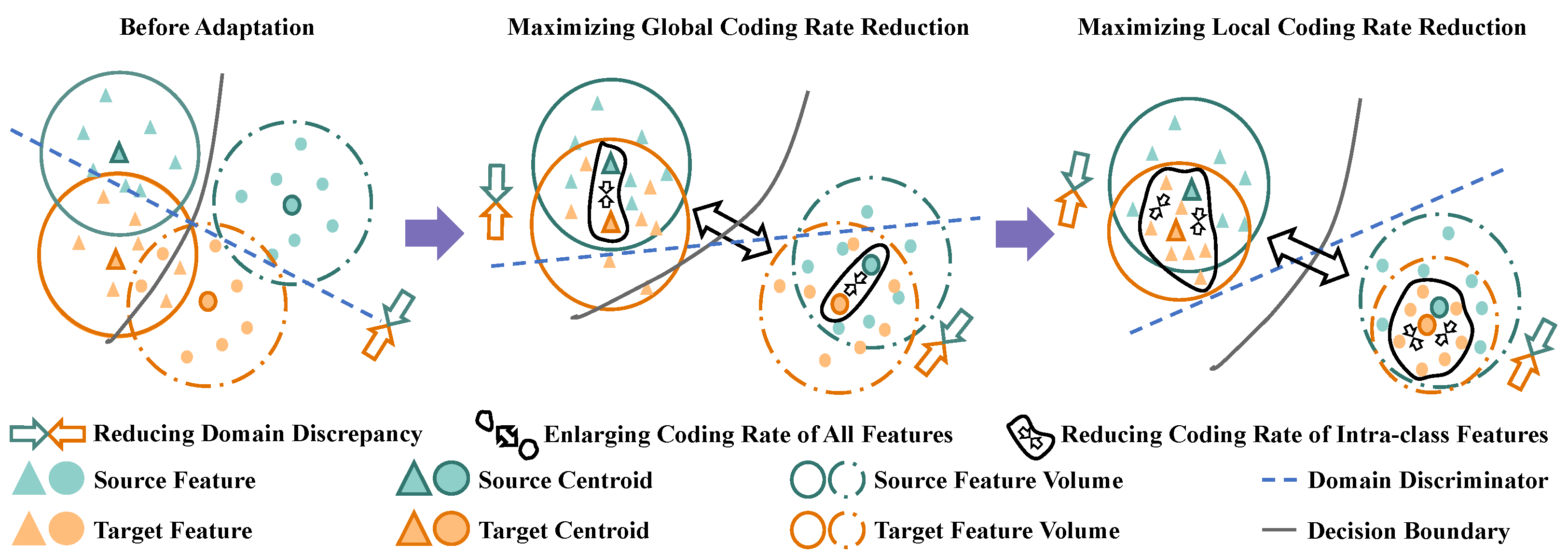
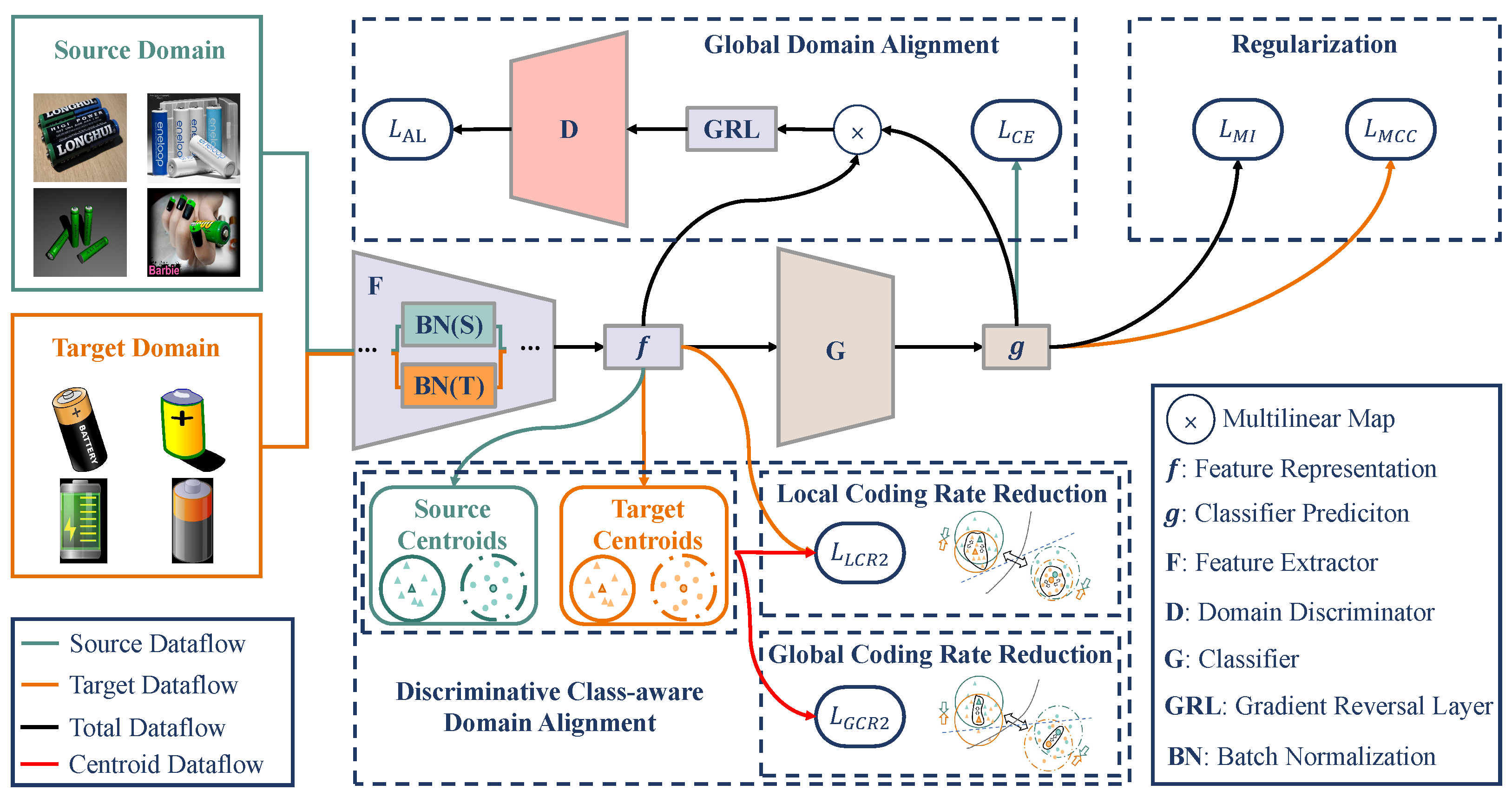
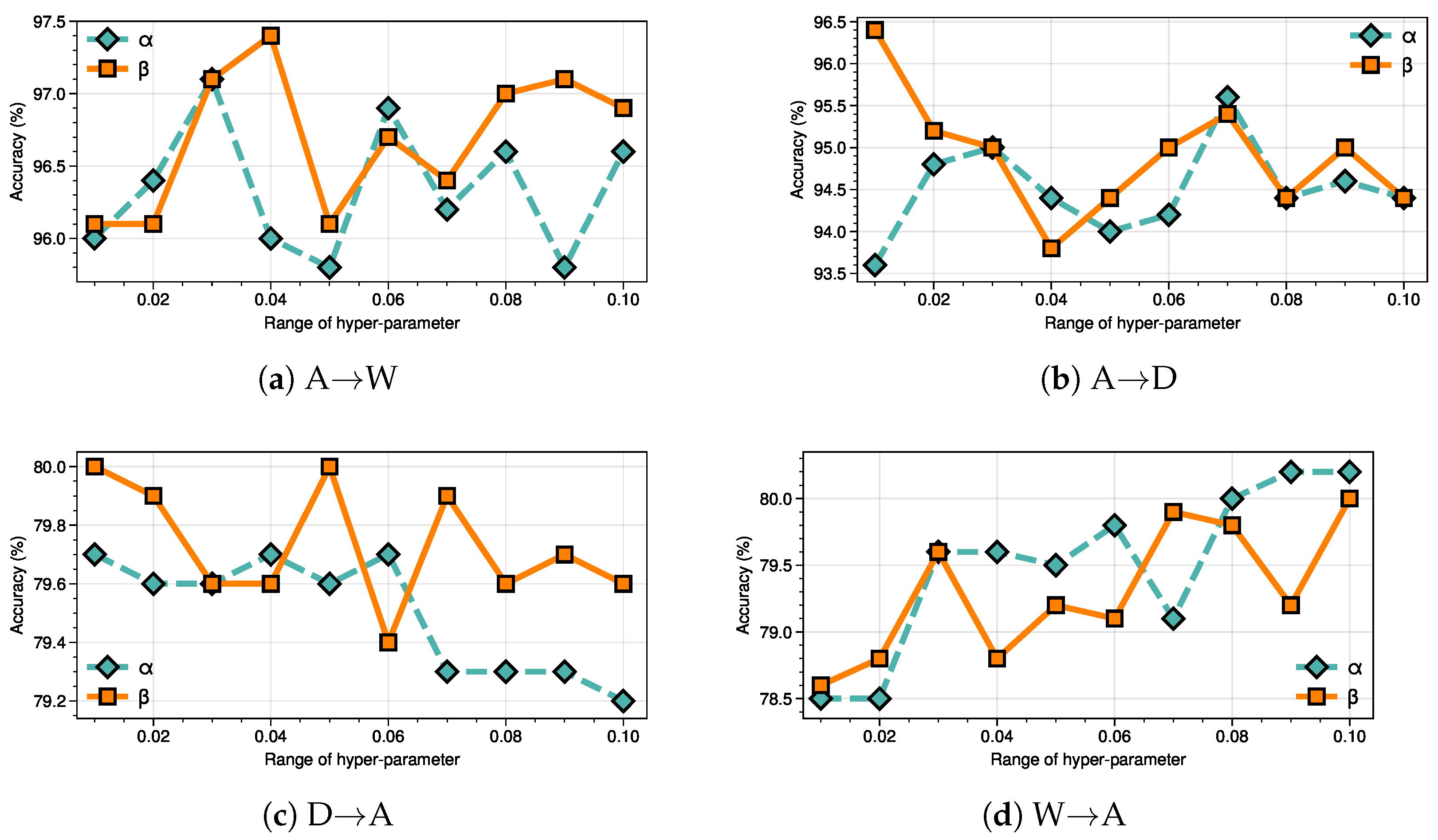



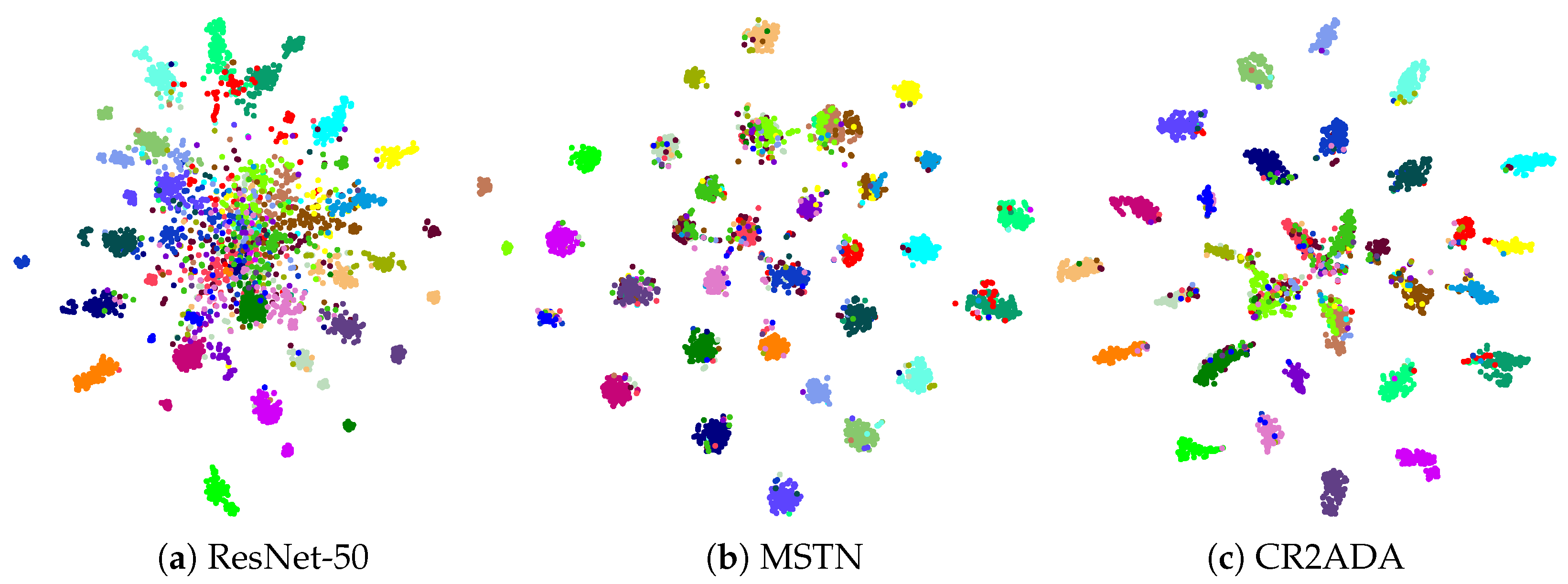
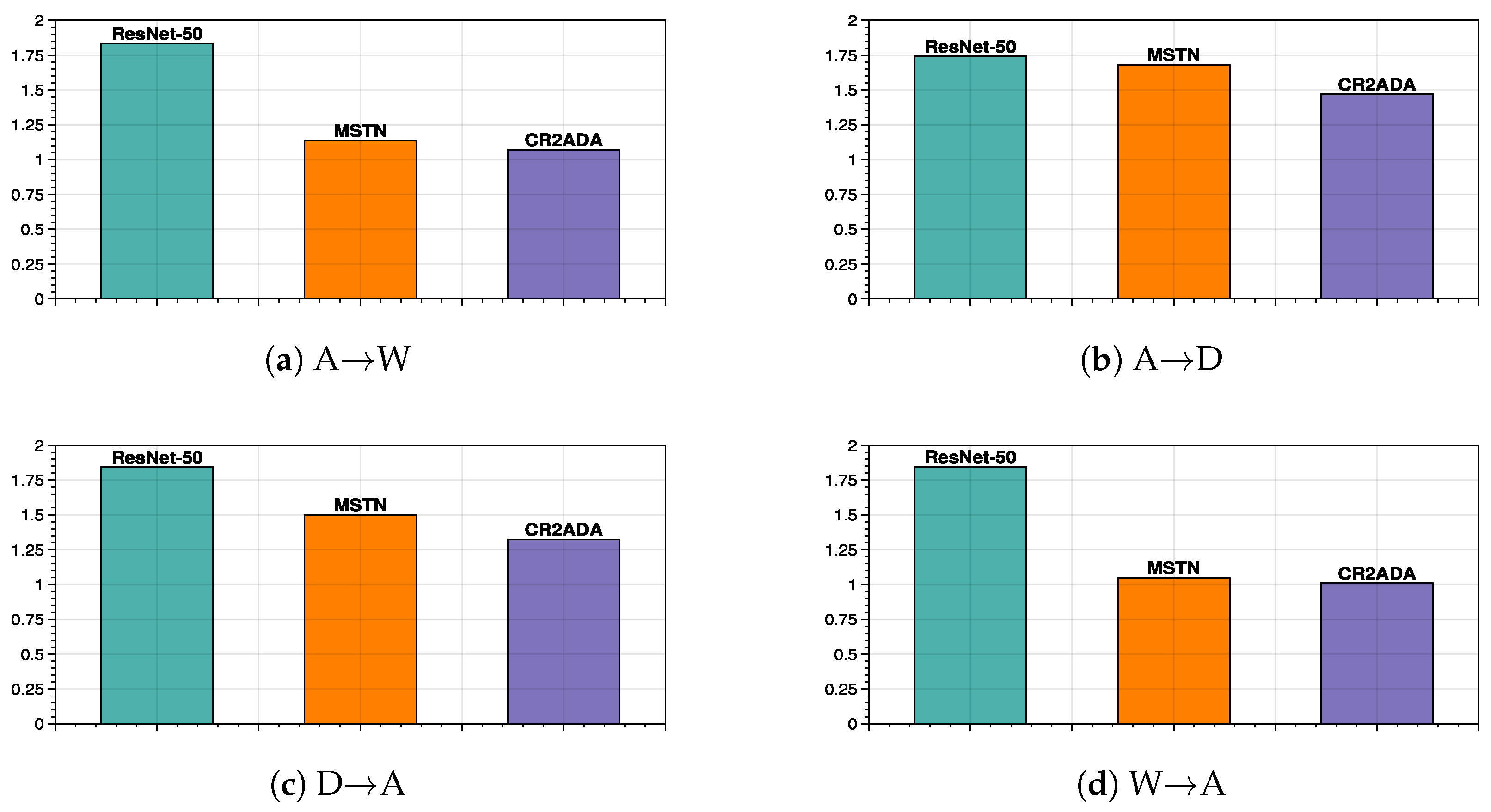
| Setup | ImageCLEF-DA | Office-31 | Office-Home | VisDA-2017 |
|---|---|---|---|---|
| backbone | ResNet-50 | ResNet-50 | ResNet-50 | ResNet-101 |
| number of training iterations | 20,000 | 20,000 | 20,000 | 50,000 |
| batch size | 32 | 32 | 32 | 32 |
| GCR2 weight parameter | 0.03 | 0.03 | 0.06 | 0.03 |
| LCR2 weight parameter | 0.03 | 0.03 | 0.03 | 0.003 |
| precision for and | 0.5 | 0.5 | 0.5 | 0.5 |
| moving average coefficient for updating centroid | 0.7 | 0.7 | 0.7 | 0.7 |
| filter threshold for | 0.05 | 0.05 | 1 | 0.1 |
| Category | Method |
|---|---|
| statistical divergence matching-based method | CAN [13], ETD [20], COT [21] |
| adversarial learning-based method | CDAN [30], MCD [31], SWD [32], BCDM [33], CGDM [34], CDAL [10], DALN [35] |
| other recent approaches | DMAL [51], SUDA [52], SIDA [25], PGFL [53], FUDA [54], IndUDA [14], GeT [55], HMA [26], CDICL [27], DTR [28] |
| Method | Venue | I→P | P→I | I→C | C→I | C→P | P→C | Avg. |
|---|---|---|---|---|---|---|---|---|
| ResNet-50 | CVPR16 | 74.8 | 83.9 | 91.5 | 78.0 | 65.5 | 91.2 | 80.7 |
| ETD | CVPR20 | 81.0 | 91.7 | 98.1 | 92.8 | 77.9 | 97.2 | 90.5 |
| CDAN+E | NIPS18 | 77.7 | 90.7 | 97.7 | 91.3 | 74.2 | 94.3 | 87.7 |
| BCDM | AAAI21 | 79.5 | 93.2 | 96.8 | 91.3 | 78.9 | 95.8 | 89.3 |
| CGDM | CVPR21 | 78.7 | 93.3 | 97.5 | 92.7 | 79.2 | 95.7 | 89.5 |
| CDAL | ACM MM22 | 80.4 | 93.7 | 97.8 | 93.3 | 80.2 | 97.5 | 90.5 |
| DALN | CVPR22 | 79.8 | 94.5 | 98.0 | 94.2 | 80.0 | 97.5 | 90.7 |
| DMAL | TNNLS22 | 80.3 | 93.2 | 96.5 | 90.5 | 76.3 | 96.0 | 88.8 |
| PGFL | PR23 | 78.7 | 92.9 | 96.2 | 94.2 | 80.2 | 96.8 | 89.8 |
| CR2ADA | proposed method | 81.5 ± 0.3 | 95.2 ± 0.3 | 98.6 ± 0.3 | 95.6 ± 0.3 | 82.3 ± 0.2 | 97.8 ± 0.2 | 91.9 ± 0.1 |
| Method | Venue | A→W | D→W | W→D | A→D | D→A | W→A | Avg. | Avg. ‡ |
|---|---|---|---|---|---|---|---|---|---|
| ResNet-50 | CVPR16 | 68.4 | 96.7 | 99.3 | 68.9 | 62.5 | 60.7 | 76.1 | 65.1 |
| CAN | CVPR19 | 94.5 | 99.1 | 99.8 | 95.0 | 78.0 | 77.0 | 90.6 | 86.1 |
| ETD | CVPR20 | 92.1 | 100.0 | 100.0 | 88.0 | 71.0 | 67.8 | 86.2 | 79.7 |
| COT | CVPR23 | 96.5 | 99.1 | 100.0 | 96.1 | 76.7 | 77.4 | 91.0 | 86.7 |
| CDAN+E | NIPS18 | 94.1 | 98.6 | 100.0 | 92.9 | 71.0 | 69.3 | 87.7 | 81.8 |
| BCDM | AAAI21 | 95.4 | 98.6 | 100.0 | 93.8 | 73.1 | 73.0 | 89.0 | 83.8 |
| DALN | CVPR22 | 95.2 | 99.1 | 100.0 | 95.4 | 76.4 | 76.5 | 90.4 | 85.9 |
| DMAL | TNNLS22 | 88.4 | 99.2 | 100.0 | 89.1 | 71.8 | 70.8 | 86.6 | 80.0 |
| SUDA | CVPR22 | 90.8 | 98.7 | 100.0 | 91.2 | 72.2 | 71.4 | 87.4 | 81.4 |
| SIDA | IJCAI22 | 94.5 | 99.2 | 100.0 | 95.7 | 76.6 | 76.2 | 90.4 | 85.8 |
| PGLS | PR23 | 90.7 | 99.1 | 99.8 | 93.8 | 78.1 | 76.4 | 89.6 | 84.8 |
| FUDA | KBS23 | 96.4 | 100.0 | 100.0 | 96.1 | 76.3 | 79.4 | 91.4 | 87.1 |
| IndUDA | IJCAI23 | 95.8 | – | – | 96.6 | 78.9 | 78.1 | 91.4 | 87.4 |
| GeT | ICCV23 | 95.8 | 99.1 | 100.0 | 96.7 | 78.6 | 77.8 | 91.2 | 87.2 |
| HMA | ICCV23 | 95.1 | 99.3 | 100.0 | 95.8 | 79.3 | 77.6 | 91.2 | 87.0 |
| CDICL | KBS24 | 96.5 | 99.2 | 100.0 | 94.1 | 77.3 | 77.5 | 90.8 | 86.4 |
| DTR | ESA24 | 95.6 | 99.0 | 100.0 | 94.6 | 76.4 | 75.6 | 90.2 | 85.6 |
| CR2ADA | proposed method | 97.1 | 98.6 | 100.0 | 95.0 | 79.6 | 79.6 | 91.7 | 87.8 |
| Method | Venue | Ar→Cl | Ar→Pr | Ar→Rw | Cl→Ar | Cl→Pr | Cl→Rw | Pr→Ar | Pr→Cl | Pr→Rw | Rw→Ar | Rw→Cl | Rw→Pr | Avg. |
|---|---|---|---|---|---|---|---|---|---|---|---|---|---|---|
| ResNet-50 | CVPR16 | 34.9 | 50.0 | 58.0 | 37.4 | 41.9 | 46.2 | 38.5 | 31.2 | 60.4 | 53.9 | 41.2 | 59.9 | 46.1 |
| ETD | CVPR20 | 51.3 | 71.9 | 85.7 | 57.6 | 69.2 | 73.7 | 57.8 | 51.2 | 79.3 | 70.2 | 57.5 | 82.1 | 67.3 |
| COT | CVPR23 | 57.6 | 75.2 | 83.2 | 67.8 | 76.2 | 75.7 | 65.4 | 56.2 | 82.4 | 75.1 | 60.7 | 84.7 | 71.7 |
| CDAN+E | NIPS18 | 50.7 | 70.6 | 76.0 | 57.6 | 70.0 | 70.0 | 57.4 | 50.9 | 77.3 | 70.9 | 56.7 | 81.6 | 65.8 |
| CDAL | ACM MM22 | 59.5 | 77.8 | 80.0 | 67.0 | 77.1 | 76.6 | 66.6 | 56.2 | 81.8 | 74.3 | 60.6 | 84.6 | 71.8 |
| DALN | CVPR22 | 57.8 | 79.9 | 82.0 | 66.3 | 76.2 | 77.2 | 66.7 | 55.5 | 81.3 | 73.5 | 60.4 | 85.3 | 71.8 |
| DMAL | TNNLS22 | 48.1 | 70.6 | 76.6 | 60.8 | 67.7 | 68.8 | 62.5 | 51.2 | 78.1 | 73.3 | 54.0 | 81.7 | 66.1 |
| SIDA | IJCAI22 | 57.2 | 79.1 | 81.7 | 67.1 | 74.5 | 77.3 | 67.2 | 53.9 | 82.5 | 71.4 | 58.7 | 83.3 | 71.2 |
| PGLS | PR23 | 50.7 | 76.8 | 80.0 | 64.3 | 77.8 | 80.2 | 64.9 | 53.7 | 81.3 | 70.1 | 54.7 | 82.8 | 69.8 |
| FUDA | KBS23 | 62.3 | 79.4 | 82.8 | 67.7 | 76.1 | 77.0 | 68.9 | 58.4 | 81.3 | 74.9 | 62.6 | 84.2 | 73.0 |
| IndUDA | IJCAI23 | 61.9 | 80.2 | 83.0 | 70.3 | 78.9 | 78.8 | 70.9 | 59.6 | 84.0 | 76.1 | 63.0 | 85.4 | 74.3 |
| GeT | ICCV23 | 60.5 | 78.8 | 82.9 | 69.1 | 79.7 | 78.8 | 69.5 | 59.3 | 84.6 | 75.2 | 62.3 | 88.0 | 74.0 |
| HMA | ICCV23 | 60.6 | 79.1 | 82.9 | 68.9 | 77.5 | 79.3 | 69.1 | 55.9 | 83.5 | 74.6 | 62.3 | 84.4 | 73.2 |
| CDICL | KBS24 | 55.9 | 74.6 | 78.1 | 60.3 | 73.3 | 72.6 | 58.6 | 53.4 | 79.5 | 72.7 | 62.9 | 84.8 | 68.9 |
| DTR | ESA24 | 56.4 | 76.5 | 79.1 | 63.7 | 75.1 | 74.9 | 65.5 | 56.2 | 80.7 | 75.5 | 61.0 | 85.3 | 70.9 |
| CR2ADA | proposed method | 57.0 | 80.6 | 83.8 | 73.6 | 80.6 | 81.7 | 73.6 | 58.0 | 84.2 | 78.5 | 59.2 | 87.6 | 74.9 |
| Method | Venue | Plane | Bicycle | Bus | Car | Horse | Knife | Motor | Person | Plant | Skate | Train | Truck | Avg. |
|---|---|---|---|---|---|---|---|---|---|---|---|---|---|---|
| ResNet-101 | CVPR16 | 55.1 | 53.3 | 61.9 | 59.1 | 80.6 | 17.9 | 79.7 | 31.2 | 81.0 | 26.5 | 73.5 | 8.5 | 52.4 |
| CAN | CVPR19 | 97.0 | 87.2 | 82.5 | 74.3 | 97.8 | 96.2 | 90.8 | 80.7 | 96.6 | 96.3 | 87.5 | 59.9 | 87.2 |
| COT | CVPR23 | 96.9 | 89.6 | 84.2 | 74.1 | 96.4 | 96.5 | 88.6 | 82.0 | 96.0 | 94.1 | 85.1 | 62.1 | 87.1 |
| CDAN+E | NIPS18 | − | − | − | − | − | − | − | − | − | − | − | − | 70.0 |
| MCD | CVPR18 | 87.0 | 60.9 | 83.7 | 64.0 | 88.9 | 79.6 | 84.7 | 76.9 | 88.6 | 40.3 | 83.0 | 25.8 | 71.9 |
| SWD | CVPR19 | 90.8 | 82.5 | 81.7 | 70.5 | 91.7 | 69.5 | 86.3 | 77.5 | 87.4 | 63.6 | 85.6 | 29.2 | 76.4 |
| CGDM | CVPR21 | 93.4 | 82.7 | 73.2 | 68.4 | 92.9 | 94.5 | 88.7 | 82.1 | 93.4 | 82.5 | 86.8 | 49.2 | 82.3 |
| BCDM | AAAI21 | 95.1 | 87.6 | 81.2 | 73.2 | 92.7 | 95.4 | 86.9 | 82.5 | 95.1 | 84.8 | 88.1 | 39.5 | 83.4 |
| DALN | CVPR22 | − | − | − | − | − | − | − | − | − | − | − | − | 80.6 |
| CDAL | ACM MM22 | 97.5 | 84.9 | 81.0 | 70.5 | 97.1 | 97.3 | 90.6 | 80.9 | 96.2 | 94.9 | 88.2 | 48.7 | 85.7 |
| DMAL | TNNLS22 | − | − | − | − | − | − | − | − | − | − | − | − | 77.6 |
| SUDA | CVPR22 | 88.3 | 79.3 | 66.2 | 64.7 | 87.4 | 80.1 | 85.9 | 78.3 | 86.3 | 87.5 | 78.8 | 74.5 | 79.8 |
| SIDA | IJCAI22 | 95.4 | 83.1 | 77.1 | 64.6 | 94.5 | 97.2 | 88.7 | 78.4 | 93.8 | 89.9 | 85.2 | 59.4 | 84.0 |
| FUDA | KBS23 | 93.4 | 88.2 | 84.1 | 84.5 | 96.1 | 82.3 | 93.7 | 82.0 | 93.4 | 77.2 | 93.9 | 46.7 | 84.6 |
| IndUDA | IJCAI23 | 97.6 | 89.6 | 86.1 | 81.3 | 96.6 | 96.0 | 90.0 | 81.8 | 95.4 | 92.2 | 88.9 | 60.3 | 88.0 |
| HMA | ICCV23 | 97.6 | 88.4 | 84.3 | 76.0 | 98.4 | 97.1 | 91.3 | 81.4 | 97.0 | 96.7 | 88.8 | 60.7 | 88.1 |
| CDICL | KBS24 | 96.0 | 79.6 | 80.5 | 59.7 | 94.5 | 95.3 | 89.9 | 79.4 | 92.1 | 85.8 | 88.0 | 38.2 | 81.5 |
| DTR | ESA24 | 94.2 | 75.1 | 80.2 | 66.1 | 92.1 | 89.6 | 94.9 | 80.8 | 90.9 | 76.4 | 89.2 | 50.3 | 81.7 |
| CR2ADA | proposed method | 97.9 | 86.0 | 81.2 | 67.0 | 96.2 | 89.7 | 91.7 | 84.8 | 93.1 | 94.2 | 90.6 | 60.7 | 86.1 |
| GDA | GCR2 | LCR2 | REG | A→W | A→D | D→A | W→A | Avg. |
|---|---|---|---|---|---|---|---|---|
| ✕ | ✕ | ✕ | ✕ | 94.1 | 89.6 | 70.1 | 76.0 | 78.6 |
| ✓ | ✕ | ✕ | ✕ | 94.2 | 95.4 | 76.5 | 76.0 | 85.5 |
| ✓ | ✓ | ✕ | ✕ | 94.6 | 95.0 | 77.7 | 79.1 | 86.6 |
| ✓ | ✕ | ✓ | ✕ | 96.4 | 94.6 | 77.9 | 76.9 | 86.4 |
| ✓ | ✓ | ✓ | ✕ | 95.1 | 95.6 | 78.3 | 79.2 | 87.1 |
| ✓ | ✓ | ✕ | ✓ | 97.4 | 94.0 | 79.7 | 78.6 | 87.4 |
| ✓ | ✕ | ✓ | ✓ | 97.5 | 94.4 | 79.2 | 78.7 | 87.5 |
| ✓ | ✓ | ✓ | ✓ | 97.1 | 95.0 | 79.6 | 79.6 | 87.8 |
Disclaimer/Publisher’s Note: The statements, opinions and data contained in all publications are solely those of the individual author(s) and contributor(s) and not of MDPI and/or the editor(s). MDPI and/or the editor(s) disclaim responsibility for any injury to people or property resulting from any ideas, methods, instructions or products referred to in the content. |
© 2024 by the authors. Licensee MDPI, Basel, Switzerland. This article is an open access article distributed under the terms and conditions of the Creative Commons Attribution (CC BY) license (https://creativecommons.org/licenses/by/4.0/).
Share and Cite
Wu, J.; Fang, Y. Towards Discriminative Class-Aware Domain Alignment via Coding Rate Reduction for Unsupervised Adversarial Domain Adaptation. Symmetry 2024, 16, 1216. https://doi.org/10.3390/sym16091216
Wu J, Fang Y. Towards Discriminative Class-Aware Domain Alignment via Coding Rate Reduction for Unsupervised Adversarial Domain Adaptation. Symmetry. 2024; 16(9):1216. https://doi.org/10.3390/sym16091216
Chicago/Turabian StyleWu, Jiahua, and Yuchun Fang. 2024. "Towards Discriminative Class-Aware Domain Alignment via Coding Rate Reduction for Unsupervised Adversarial Domain Adaptation" Symmetry 16, no. 9: 1216. https://doi.org/10.3390/sym16091216
APA StyleWu, J., & Fang, Y. (2024). Towards Discriminative Class-Aware Domain Alignment via Coding Rate Reduction for Unsupervised Adversarial Domain Adaptation. Symmetry, 16(9), 1216. https://doi.org/10.3390/sym16091216






